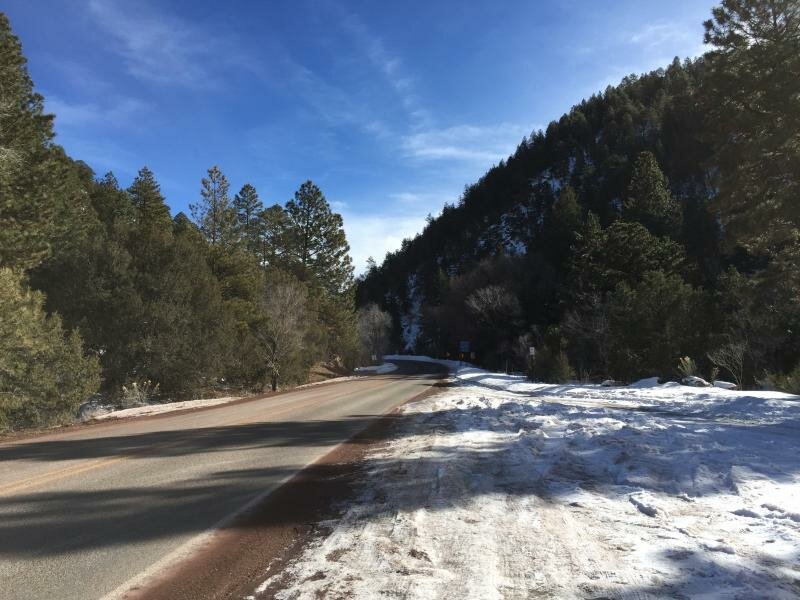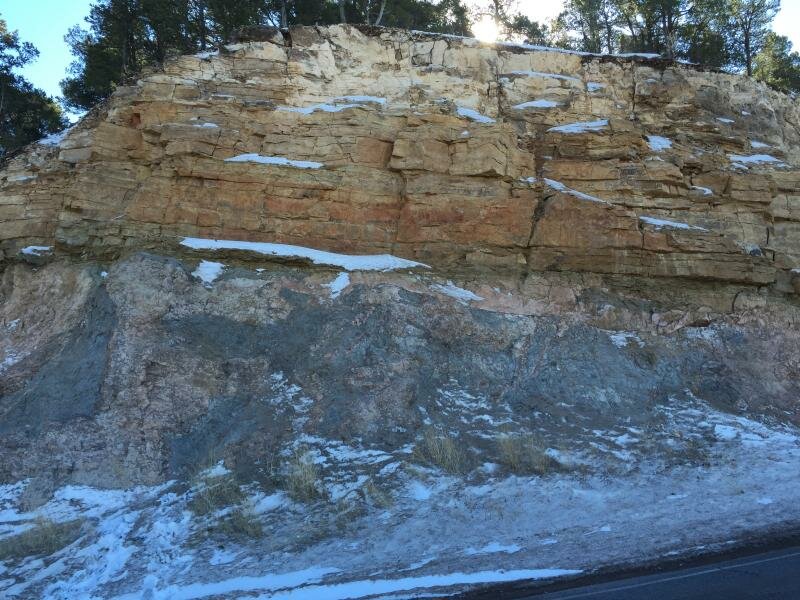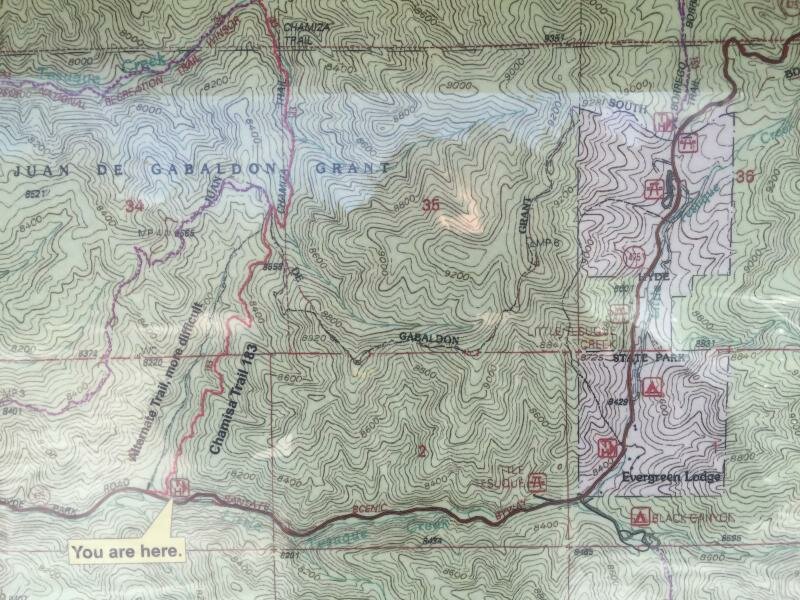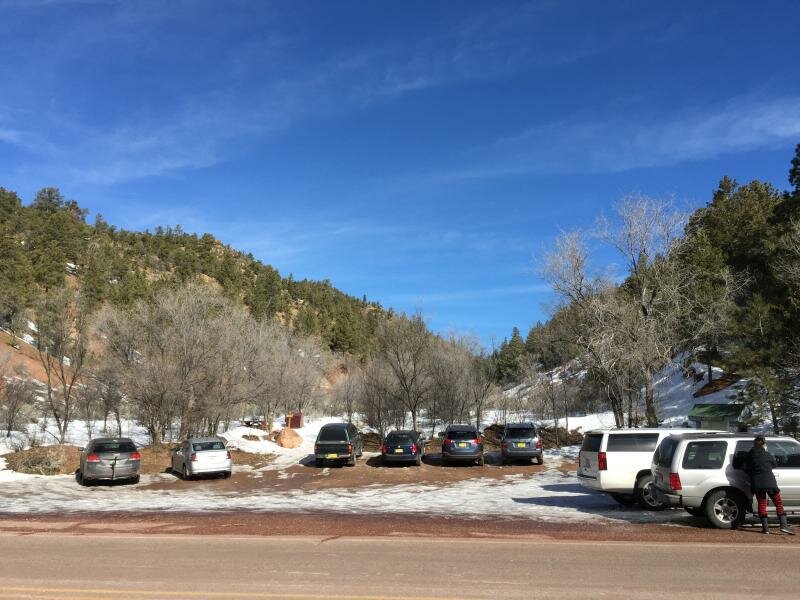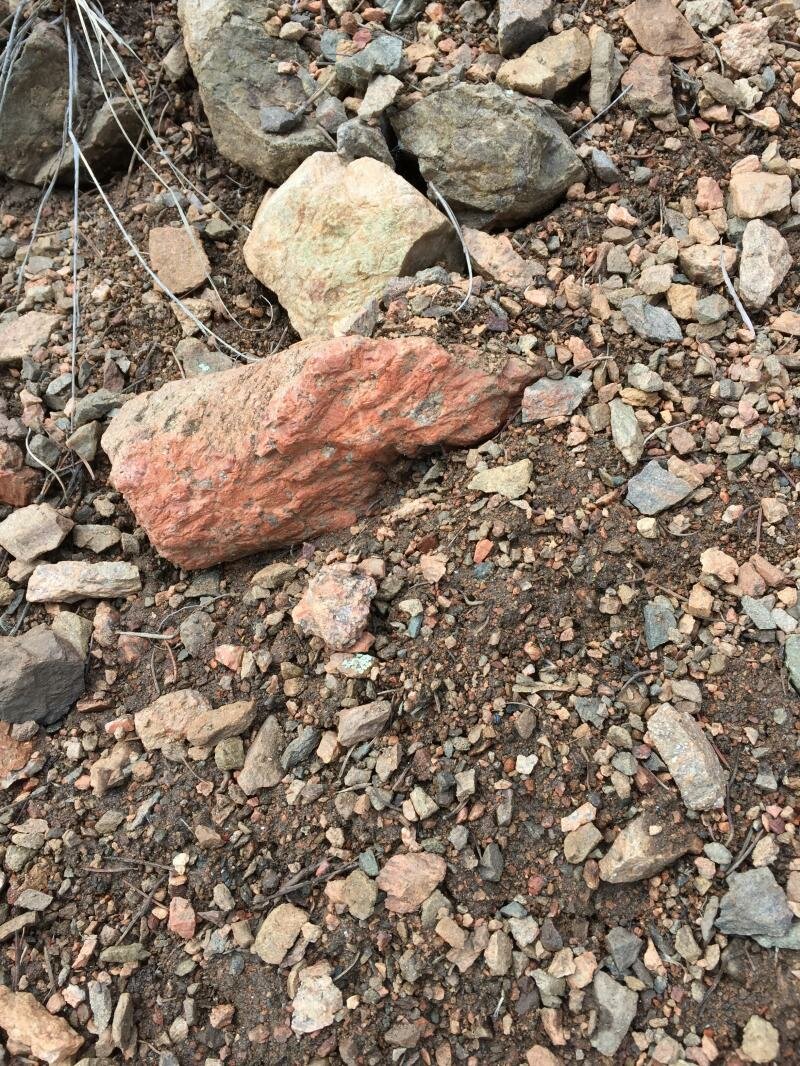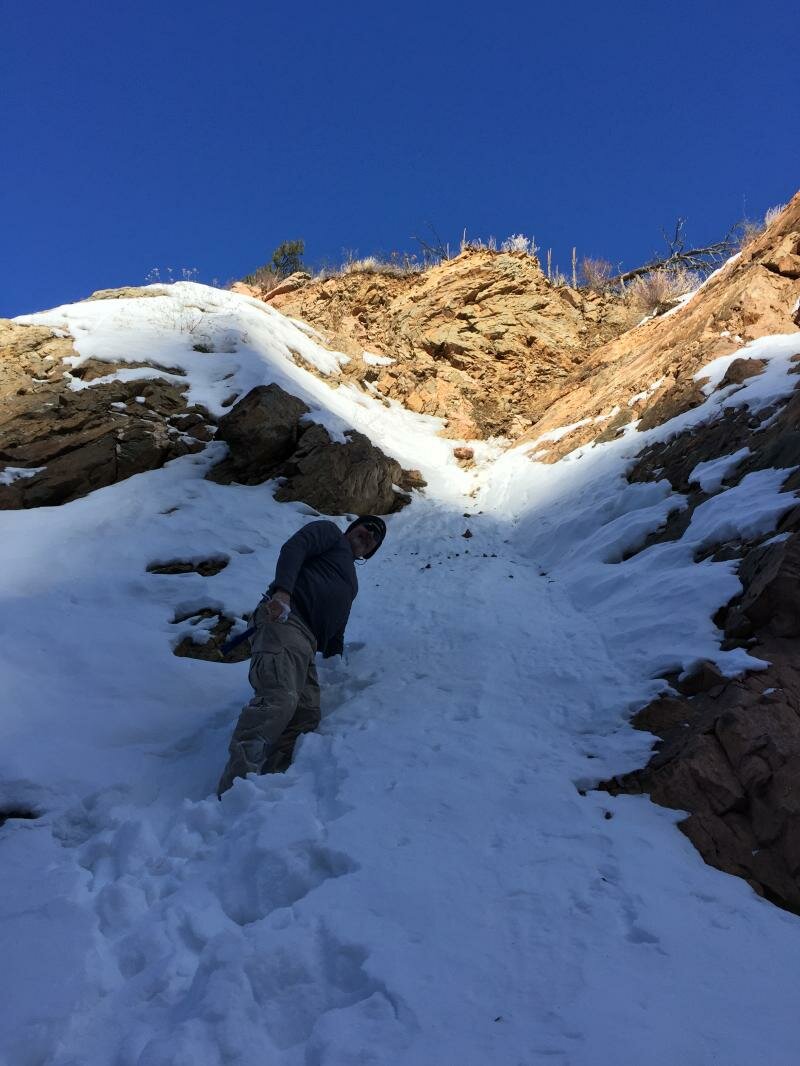United States Meteorite Impact Craters
- Home
- Crater Identification
- Alamo, Nevada
- Ames, Oklahoma
- Avak, Alaska
- Barringer, Arizona
- Beaverhead, Montana
- Chesapeake Bay, Virginia
- Cloud Creek, Wyoming
- Crooked Creek, Missouri
- Decaturville, Missouri
- Decorah, Iowa
- Des Plaines, Illinois
- Flynn Creek, Tennessee
- Glasford, Illinois
- Glover Bluff, Wisconsin
- Haviland, Kansas
- Kentland, Indiana
- Manson, Iowa
- Marquez, Texas
- Middlesboro, Kentucky
- Newporte, North Dakota
- Odessa, Texas
- Red Wing, North Dakota
- Rock Elm, Wisconsin
- Santa Fe, New Mexico
- Serpent Mound, Ohio
- Sierra Madera, Texas
- Upheaval Dome, Utah
- Weaubleau, Missouri
- Wells Creek, Tennessee
- Wetumpka, Alabama
- Possible Impacts
- User-submitted Possibles
- Open Questions
- About This Website
Santa Fe impact structure, New Mexico

A downloadable PDF of the 2017 Meteoritical Society Fieldguide is available
Santa Fe Crater - The Santa Fe impact structure was discovered in 2005, when Tim McElvain stopped to look at a road cut along State Hwy 475, between Santa Fe and Hyde Memorial State Park. Shattercones were found over an area of at least 3 square kilometers (Fackelman et al., 2007, 2008). The Earth Impact Database records the site as between 6 and 13 km in diameter and less than 1.2 billion years old. The shattercone region represents a portion of the central uplift. Though heavily weathered, the structure is exposed on the surface. It is preserved in the igneous rocks of the Sangre de Cristo Mountains.
Evidence of Impact Origin
The impact origin of each location listed on this website has been supported by unambiguous diagnostic evidence of hypervelocity impact that has been reported in a scientific (usually peer reviewed) context. Without such evidence, a geological structure is not a confirmed impact crater. This section, which is included for each crater on this website, is not an exhaustive list of such published evidence, but is meant to demonstrate that appropriate work has been done for each listing.
Fackelman et al., (2008).
Nature of diagnostic evidence:
- Shatter cones.
Other significant evidence: breccia, poorly developed planar fractures in quartz.
A Visit to the Santa Fe Impact Crater:

The Santa Fe impact crater is exposed in a valley in the Sangre de Cristo Mountains, along NM 475, between Santa Fe, NM, and Hyde Memorial State Park. The best known exposures of impact altered rocks are less than 15 minutes from downtown Santa Fe, NM.
Santa Fe crater is a very old impact structure that has been buried beneath younger sediment, exposed through erosion, and deformed and obscured by repeated episodes of faulting and buckling of the impacted rocks. There is nothing at the location resembling a round, bowl shaped structure, nor a central uplift, nor any other thus-far-identified visible remnant of crater morphology defining the current surface of the land. But for the diligent student of geology or impact astrogeology, the site offers some amazing exposures of breccia and shatter cones as evidence of the ancient, catastrophic collision.
Driving up NM 475 from Santa Fe, towards Hyde State Park, one notices breccias and shattered and buckled rocks beginning several km from the shatter cone exposures that are reasonably presumed to mark the central region of the crater. But the first really astounding remnants of the impact crater are revealed in a road cut on the right hand side of a sharp curve in the road known as Nun's Curve, where unaltered Mississippian sediments sit undisturbed on top of a bed of friable breccia. The breccia is formed in impacted rocks that are about 1.2 billion years old. The Mississippian strata on top are about 330 million years old. The impact occured sometime within this span, and the missing rock layers, a period of continental erosion in this region, are referred to as the 'Great Unconformity.' Looking across the valley from this roadcut, you can see the same stratigraphic pairing capping the tops of several nearby foothills. While there is a wide shoulder at this road cut that is apparently often used, this road is heavily traveled, and people go very fast. Be careful!
A little further along 475, the visitor comes to the trail head for Chamisa Trail 183, a popular hiking trail that carves its way roughly across a portion of the center of the crater. Shatter cones are found for a substantial distance up this trail. I took the snapshot above from a USGS topographic map posted near the trail head. Shatter cones, indicating substantial shock pressures suggestive of the uplifted central portion of the crater, are found along NM 475 from a couple hundred meters or more west of Chamisa Trail all the way to where NM475 turns north, at Black Canyon, and extend about 1.5 km up Chamisa Trail. Fackelman et al. (2008) estimate a total area of shatter cone occurrence of approximately 5.5 square km.
In winter, there are very few places to park along NM 475. There may be some additional wide shoulders in summer. There are large parking areas on both sides of the road at the trail head for Chamisa Trail 183.
Having visited a number of other impact craters around the United States, I expected to find it at least a little bit challenging to locate rocks that were unambiguously altered by the impact. This was not the case, even with significant snow on the ground. The large boulder marking the trailhead of Chamisa Trail 183, at the edge of the parking lot, revealed evident shatter cones on the fractured face behind Gary Bodman's rock hammer, which is shown, along with Gary, for scale. Shatter cones are everywhere in this area, present in all nearby roadcuts, in tallus slopes along the steep walls of the canyon, and in exposed in-situ rock faces.
Chamisa Trail 183 runs up a north-south oriented shallow, scenic valley, perpendicular to NM 475. Shatter cones and breccia features are found on both sides of the valley, and extend nearly 1.5 km north of NM 475.
Shatter cones are preserved in paleoproterozoic igneous and metamorphic crystalline rocks, including granite, schist, quartzite, and amphibolites (Fackelman et al., 2008). An example is shown above, amidst tallus formed below outcrops along Chamisa Trail.
Santa Fe crater was originally discovered in 2005, by an alert geologist, Tim McElvain, near the impressive shatter cone covered road cut wall shown above, when a rock or mud slide partially blocked NM 475. According to the story, as recorded in Newsom et al., 2008, McElvain first noticed shatter cones in fragments of stone in the slide, and then realized that they were pervasive in surrounding road cuts, ranging in size up to a meter or more. These primary exposures are located a couple hundred meters or so east of the Chamisa Trail trailhead, in the direction of Hyde Memorial State Park. Sample collection at these sites is strongly discouraged, as these are unique and attractive exposures, and there is truly no shortage of material elsewhere.
Even partially covered in snow and in winter shadows, the primary published exposures of shatter cones in roadcuts along NM 475 are impressive. Gary Bodman is shown for scale on a slope on which nearly every rock shows unambiguous macroscopic evidence of impact alteration. Visitors should always remain cautious and maintain situational awareness at these exposures, as the rock is shattered and potentially unstable.
Megabreccia and shattercones are exposed for at least another 2.5 km east, past the Chamisa Trail head, as far as the Hyde Memorial State Park visitor center, near Black Canyon. Hyde Memorial State Park offers camping, hiking, picnic areas, and restroom facilities.
The image above was taken nearly across the road from the entrance to Black Canyon, in Hyde State Park. The granite here, nearly 3 km from the first exposure of shatter cones along NM 475, and 5 km from 'Nun's Curve' are still massively deformed and displaced, possibly representing titanic clasts of a megabreccia, and reveal poorly formed shatter cones, meaning that shock pressures here still exceeded 2 to 10 gigapascals, or a minimum instantaneous force of about 300,000 lbs per square inch, or nearly 20,000 atmospheres. The image below shows poorly formed, but still unambiguous, shatter cones formed amidst pervasive slickensides in the rock wall imaged above. At this location, shatter cones are sparse, and slickensides, or striated surfaces formed where rocks move against other rocks, are common. As NM 475 climbs eastward and northward, the impact altered rock units undoubtedly continue, but are no longer exposed. The regional extent of the rock subjected to adequate shock pressures to produce shatter cones, discussed and mapped in detail in Fackelman et al., 2008, suggests an impact crater that was originally as large as 10 to 15 km, and that is certainly no smaller than 6 km.
Bibliography and References:
(If links to articles don't work, don't give up. Try pasting the link shown into a search engine or searching for the article authors, title, or other reference information. If your research leads you to additional scientific references related to this crater, please help improve this resource by sending a note with the new citation(s) to: )
Adachi, T., and Kletetschka, G. (2008) A New Method of Testing the Heterogeneity of the Impact Origin, Shatter Cones of Newly Discovered Impact Site, Santa Fe, New Mexico, USA (abstract #3092). Abstracts of the Large Meteorite Impacts and Planetary Evolution IV conference.
Buchner E., Schmieder M. 2017. Shocked quartz and local selective feldspar melting in a lithic breccia dike intersecting shatter coned target rocks at the Santa Fe impact structure, New Mexico, USA (abstract #1987). Abstracts of the 80th Annual Meeting of the Meteoritical Society
Cavosie, A. J. (2014) Apatite for destruction (abstract #366). Abstracts of the 24th Goldschmidt Conference.
Cavosie A. J. 2017 Shock deformation at degraded impact craters: the Santa Fe structure (abstract #6106). Abstracts of the 80th Annual Meeting of the Meteoritical Society
Cavosie, A. J., and Lugo Centeno, C. (2014) Shocked apatite from the Santa Fe impact structure (USA): a new accessory mineral for studies of shock metamorphism (abstract #1691). Abstracts of the 45th Lunar and Planetary Science Conference.
Cavosie A. J., Montalvo P. E., N. E., Reddy S. M. 2016. The microstructure of shocked xenotime (abstract #6250). Abstracts of the 79th Annual Meeting of the Meteoritical Society
Cavosie A. J., Montalvo P. E., Timms N. E., Reddy S. M. 2016. Nanoscale deformation twinning in xenotime, a new shocked mineral, from the Santa Fe impact structure (New Mexico, USA). Geology, Volume 44, No. 10, pages 803-806. https://doi.org/10.1130/G38179.1
Colon Lugo, D., and Cavosie, A. J. (2014) Detrital shocked muscovite from the Santa Fe impact structure (USA) (abstract #2033). Abstracts of the 45th Lunar and Planetary Science Conference.
Fackelman, S. P., McElvain, T. H., Morrow, J. R., and Koeberl, C. (2007) Shatter cone exposures indicate a new bolide impact structure near Santa Fe, New Mexico (abstract #1207). Abstracts of the 38th Lunar and Planetary Science Conference.
Fackelman, S. P., Morrow, J. R., Koeberl, C., and McElvain, T. H. (2008) Shatter cone and microscopic shock-alteration evidence for a post-Paleoproterozoic terrestrial impact structure near Santa Fe, New Mexico, USA. Earth and Planetary Science Letters, volume 270, issue 3-4, pp. 290–299. doi:10.1016/j.epsl.2008.03.033
Ferrière, L., Koeberl, C., Reimold, W. U., Hecht, L., Bartosova, K. (2009) The Origin of "Toasted" Quartz in Impactites Revisited (abstract #1751). Abstracts of the 40th Lunar and Planetary Science Conference.
Lugo Centeno, C. M., and Cavosie, A. J. (2014) First report of shocked zircon at the Santa Fe impact structure (USA) (abstract #1839), Abstracts of the 45th Lunar and Planetary Science Conference.
Lugo Centeno, C. M., Cavosie, A. J., Radovan, H. A. (2012) A Search for Detrital Shocked Zircons Eroded from the Santa Fe Impact Structure, New Mexico, USA (abstract #2014). Abstracts of the 43rd Lunar and Planetary Science Conference.
Lugo-Centeno, C. M., Cavosie, A., Radovan, H. A. (2013) A Search for detrital shocked zircons in the eroded Santa Fe impact structure, New Mexico, USA (abstract). Geological Society of America Abstracts with Programs. Vol. 45, No. 2, p.61.
McElvain, T. H. (2007) Evidence for a major impact structure in the Sangre de Cristo Mountains, near Santa Fe, New Mexico (abstract). Geological Society of America Abstracts with Programs, Vol. 39, No. 5, p. 11.
Miura Y. 2017. Ocean impact evidences of Santa Fe impact structure with shocked grains (abstract #6171, poster #6203). Abstracts of the 80th Annual Meeting of the Meteoritical Society
poster at:
Montalvo, P. E. and Cavosie, A. J. (2014) Expanding the distribution of shocked bedrock at the Santa Fe impact structure (NM, USA) based on new detrital shocked mineral localities (abstract). Abstracts of the 2014 GSA Annual Meeting, Geological Society of America Abstracts with Programs. Vol. 46, No. 6, p.760.
Montalvo, P. E. and Cavosie, A. J. (2015) Expanding the Distribution of Shocked Minerals at the Santa Fe Impact Structure (NM, USA) (abstract #1337). Abstracts of the 46th Lunar and Planetary Science Conference.
Montalvo P. E., Cavosie A. J., Erickson T. M., Kirkland C. L., Evans N. J., McDonald B. J., Talavera C., Lugo-Centeno C. 2017. Detrital Shocked Zircon Provides New Constraints on the Age and Size of the Santa Fe Impact Structure, NM (USA) (abstract #6171). Abstracts of the 80th Annual Meeting of the Meteoritical Society.
Morrow, J. R., Koeberl, C., Reimold, W. U. (2008) Microscopic Shock-Alteration Features in Shatter Cones from the Santa Fe Impact Structure, New Mexico, USA (abstract #3037). Abstracts of the Large Meteorite Impacts and Planetary Evolution IV conference.
Newsom, H. E.; Elston, W. E.; Cohen, B. A.; Tegtmeier, E. L.; Petersen, M. T.; Read, A. S.; McElvain, T. H. (2007) Evidence for an Impact Structure in the Sangre de Cristo Mountains near Santa Fe, New Mexico (abstract). Abstracts of the 70th Annual Meteoritical Society Meeting, Meteoritics and Planetary Science Supplement, Vol. 42, p.5307.
Newsom, H., Elston, W., and Tegtmeier, E. (2008) Evidence for a major impact structure in the Sangre de Cristo Mountains, near Santa Fe, New Mexico, A Field Guide. Field trip guide prepared for the University of New Mexico E&PS alumni reunion.
Siobhan P. Fackelman, Jared R. Morrow, Christian Koeberl, Thornton H. McElvain, Shatter cone and microscopic shock-alteration evidence for a post-Paleoproterozoic terrestrial impact structure near Santa Fe, New Mexico, USA, Earth and Planetary Science Letters, Volume 270, Issues 3–4, 30 June 2008, Pages 290-299.
Tegtmeier, E. L., Newsom, H. E., Elston, W. E., McElvain, T. H. (2008) Breccias and geological setting of the Santa Fe, New Mexico USA impact (abstract #3090). Abstracts of the Large Meteorite Impacts and Planetary Evolution IV conference.
Wright S. P., Cavosie A. J. (2017) Recognizing Criteria for Ancient Impacts: A Workshop and Field Guide for the Santa Fe Impact Structure. S. P. Wright and A. J. Cavosie (organizers). 80th Annual Meeting of the Meteoritical Society. 28 pages.
https://impactcraters.us/fieldguideSF2017.pdf
Wright S. P., Cavosie A. J. (2017) Shatter cones and breccias of the Santa Fe impact structure, in: Recognizing Criteria for Ancient Impacts: A Workshop and Field Guide for the Santa Fe Impact Structure. S. P. Wright and A. J. Cavosie (organizers). 80th Annual Meeting of the Meteoritical Society. 28 pages.
https://impactcraters.us/fieldguideSF2017.pdf
Wright, S. P., Tegtmeier, E. L., Newsom, H. E. (2010) Diversity of breccias associated with the Santa Fe impact structure (abstract #1286). Abstracts of the 41st Lunar and Planetary Science Conference.
Zaag, P. T., Hasch, M., Reimold, W. U., Raschke, U., Hipsley, C. A., Hess, K.-U., Dobson, K. J. (2015) New laboratory and field studies on shatter cones (abstract #1077). Abstracts of the Bridging the Gap III: Impact Cratering In Nature, Experiments, and Modeling conference.
----------------------------------
Excellent non-technical summaries at:
Mullen, L. (2010) The Impact that Shattered Santa Fe. Astrobiology Magazine
Wallendahl, A. (2011) Santa Fe impact crater discovery: A series of fortunate events, Earth magazine
Copyright 2011, 2012, 2013, 2014, 2015, 2016 United States Meteorite Impact Craters. All rights reserved.

